Retrospective technology startups. As it was in the 90s and a little earlier.
Previous article in the cycle: Retrospective technology startups. Z3 - the first relay computer.
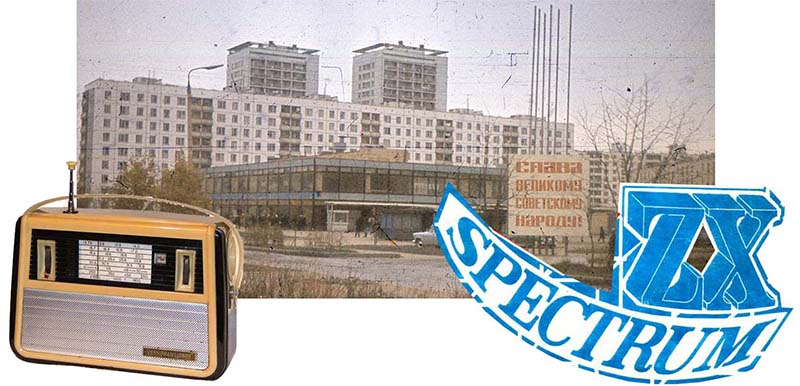
In this article I continue the retrospective of startups. Fast forward from Germany to World War II to young Russia in the early 1990s of the last century. This time there will be many examples of how this happened in Zelenograd and an attempt to answer the question: “How and why did electronics business grow from scratch by leaps and bounds at that time?”
But first, let's take a quick look at the sunset era of the USSR star.
In late Soviet times, the production of electronics outside the public sector was very bad. In today's sense, it is simply absent. Yes, already then there were cooperatives, artels and citizens working under a patent, but in completely different areas.
In the late eighties, even the magazine “Radio” was not easy to get, let alone radio parts. Rare, especially in the provinces, radio stores were filled with customers, but as part of them there were, at best, sets of resistances and already then hopelessly outdated transistors of the MP39 type, and at very inflated prices.
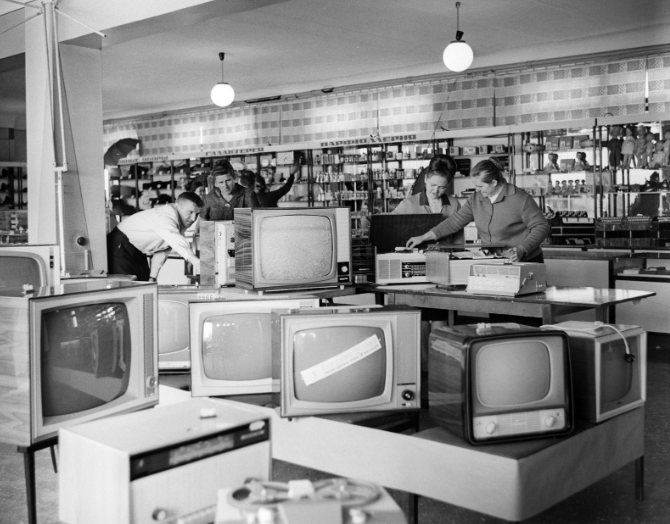
The assortment of “do-it-yourself” stores was somewhat more interesting, however, they were far from being in every settlement. They could buy equipment that was decommissioned from salons in a semi-disassembled condition, and if you were lucky, it was a seriously discounted new product that did not pass quality control at work or had external defects. The main supplier of the most interesting and desired details was, of course, the money-clothing markets, commonly referred to as “flea market” in common people. There you could buy a lot of things - KT315 transistors, logic chips and even thyristors for color music. Particularly lucky had access to specialized landfills at the plants. Only testers were easily accessible from measuring instruments.
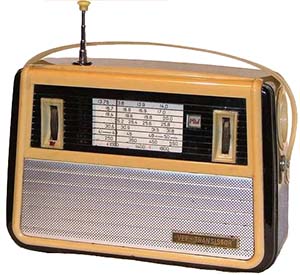
Private "production" was a craft under the roof of amateur radio, based on "communicated" from the production of parts and grouped around the relevant factories. Enthusiasts modified the radio receivers to receive broadcasting on the unused shortwave bands in the USSR, where foreign voices were jammed with less intensity, made the simplest color-music set-top boxes to order, modified power amplifiers and acoustics, assembled radio control equipment for models ... But all this is a maximum of several copies.
In the second half of the 80s in the USSR, with the help of children of diplomats, foreign students, athletes and other mysterious ways, individual instances of household computers, focused primarily on games, began to penetrate. However, it was much more difficult to meet the original ZX Spectrum in the USSR than, for example, such foreign PCs like the Atari, the Commodore 64 or MSX.
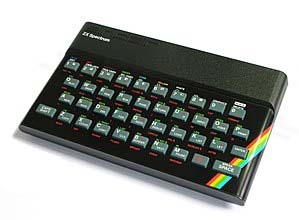 Spectrum in almost all important parameters was clearly inferior to both Atari and MSX, and even the first Soviet home computer BK-0010/0011, whose architecture was built on the basis of an advanced 16-bit processor. However, when the ZX Spectrum fell into the hands of electronics engineers, they quickly were able to assess its strengths.
Spectrum in almost all important parameters was clearly inferior to both Atari and MSX, and even the first Soviet home computer BK-0010/0011, whose architecture was built on the basis of an advanced 16-bit processor. However, when the ZX Spectrum fell into the hands of electronics engineers, they quickly were able to assess its strengths.
ZX Spectrum appeared thanks to the famous inventor - businessman Clive Sinclair in 1982 in the UK. He initially thought of as the cheapest home PC with color graphics support. To reduce the cost, it used the simplest keyboard of all 40 buttons, each of which carried up to six functions, including several BASIC operators. But the most unique in the Spectrum - is its graphical mode. Firstly, it is only one, unlike most other PCs of those years, which usually had several video modes, and secondly, the video system was capable of displaying 16 colors with a resolution of 256 × 192 pixels high enough for games and at the same time requiring less than 7 KB of video memory . Due to the wide border, the picture did not occupy too much of the screen, but it had good quality.
At that time, there were many specialists in the USSR specializing in the cloning of foreign products of electronic equipment, which made it possible in less than a year to create a simple and cheap clone ZX Spectrum on the basis of widespread domestic logic.
Comparative simplicity of the architecture is only one video mode, the lack of hardware sprites, character generator, scrolling, sound synthesizer, etc. allowed to very accurately simulate the "Spectrum" on the usual Soviet element base. Trivia, such as the incorrect operation of the video controller and the crookedly realized connection of the joystick, were outweighed by the low cost of assembly and the availability of components.
But the main advantage, compared with domestic domestic PCs produced at that time, was that it was developed a couple of orders of magnitude more games and other applications.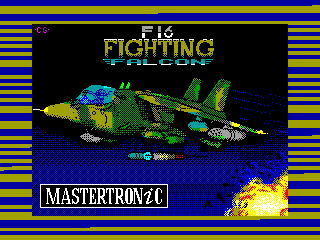 The number of Spectrum-compatible Soviet models grew like a snowball, and in the early 1990s, literally dozens of factories produced them, greatly pushing back the original domestic developments to the background.
The number of Spectrum-compatible Soviet models grew like a snowball, and in the early 1990s, literally dozens of factories produced them, greatly pushing back the original domestic developments to the background.
Circuitry Spectrum-compatible PC, developed by amateur enthusiasts in the second half of the 80s. The “Spectrum” scheme was unknown in details - in the original PC, one specialized ULA chip was used to reduce the cost of production instead of dozens of individual logic chips, hiding the logic of operation. Therefore, the authors of Spectrum-compatible computers were looking for their own solutions that simulate the operation of the prototype in accordance with the known external specifications - memory allocation, screen organization and the designation of control ports. Usually, Soviet counterparts contained about 45–80 microchips, which made them quite simple and cheap to manufacture. At the first stage, everything except the processor was produced by the domestic industry.

Since 1991, during the Spectrum boom, in Zelenogradand not only began the production of processors that are fully compatible with the Z80 T34BM1 , and the specialized microcircuits of the BMC T34VG1, KA1515XM1 , ROM T34PE1 and others. Allowed to place almost the entire circuit on a single chip and reduce the number of chips in the minimum version to 16.
At the end of the eight, imported circuits began to penetrate into significant quantities due to the cordon. Very quickly they got to the MIET hostel.
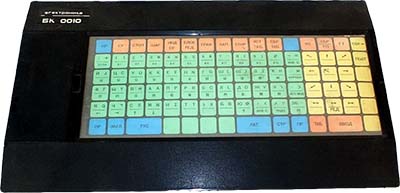 By the time senior students were quite ready to master the Spectrum. I with three of my classmates threw off 150 rubles each and became the first owners of household computers BK-0010 that have just appeared in our hostel. It was possible to write simple programs on BASIC on it, but the game applications were practically absent. This prompted to start developing their own games. I will never forget the delights of graphics control in PDP-11 machine codes, since even the assembler was missing, and the basic in firmware ROM could not work with graphics. Taking into account the preservation of programs on a household tape recorder and the instability of the power grid, this was quite a non-trivial task.
By the time senior students were quite ready to master the Spectrum. I with three of my classmates threw off 150 rubles each and became the first owners of household computers BK-0010 that have just appeared in our hostel. It was possible to write simple programs on BASIC on it, but the game applications were practically absent. This prompted to start developing their own games. I will never forget the delights of graphics control in PDP-11 machine codes, since even the assembler was missing, and the basic in firmware ROM could not work with graphics. Taking into account the preservation of programs on a household tape recorder and the instability of the power grid, this was quite a non-trivial task.
So without finishing the first game to the end, I became fascinated with mountain tourism and for a while computers moved into the background into my life. A couple of other “concessionaires”, on the contrary, got carried away in earnest. And now, towards the end of 1988, not only the imported 8-bit Z-80 processor , but also the circuit of the legendary Sinclair ZX Spectrum , fell into my hands by unknown means . By that time, the guys already had experience in assembling and adjusting the RC-86 computer on a blindfly, therefore, it was not too difficult to repeat this feat with the Spectrum.
The appearance of a gaming computer in their room could not go unnoticed by numerous friends. The room instantly turned into a sort of “showroom”. A week later, they made an offer to buy from which they could not refuse. Moreover, a virtual queue of potential customers was soon formed, ready to pay the money in advance.
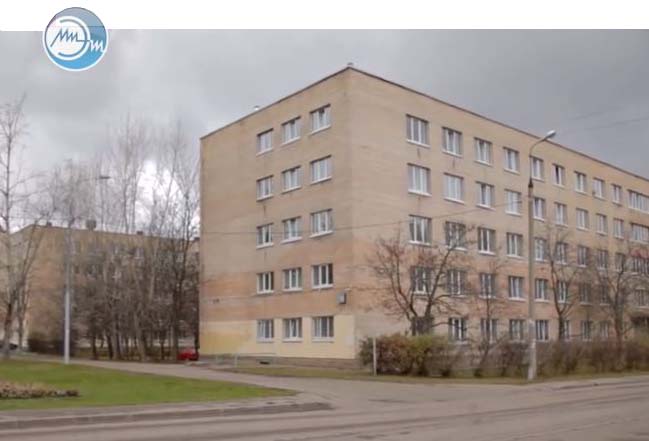
In the hostel, consisting of 6 residential buildings, connected together by a common corridor, the news spread very quickly, even without the Internet. Soon my friends had a third partner who had a commercial vein.
Friends enrolled in graduate school, study and research began to take a lot of time. To solder, tune, debug ready boards, search for cases, cram content into them ... it was too long and not too interesting. In such conditions, it was much more suitable to assemble sets for self-assembly for them than to assemble ready-made computers. Especially in the student environment of Zelenograd, where many were friends with a soldering iron. What my friends and do.
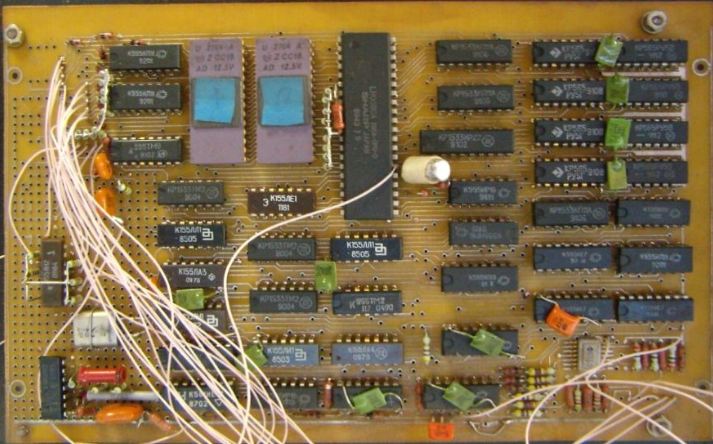
It cannot be said that the information in those days was very expensive - it was very difficult to access. There was neither the fact that the Internet - typewriters had to register with the KGB! The first scheme I had to shoot as a copy of tracing paper.
By that time I had already graduated from the institute and, unlike the children, I could not gain a foothold in graduate school.too much time was taken by mountain hikes . Considering my share in BK-0010, I bought the full set of Leningrad-1 motherboards from them almost at cost price — 120 rubles about two times lower than their standard price and went to Tver. For comparison, in order to estimate the profit rates of those years, in a thrift shop the price for a ready-made ZX Spectrum reached 1,000 rubles.
 My friends' business ended as quickly and swiftly as it began. One of them did not share the girl with the merchant who joined them and there was a serious quarrel. For one and a half years of activity of their enterprise, the local market with a sales channel in the form of a word of mouth was almost saturated. The year of 1991 was approaching and many were no longer up to gaming computers. The number of components produced by “barter schemes” was limited. In order to move to other scales, everything had to be changed - the organizational structure, the delivery channels for bundling and marketing. Perhaps they would go for it, but in the summer, in
My friends' business ended as quickly and swiftly as it began. One of them did not share the girl with the merchant who joined them and there was a serious quarrel. For one and a half years of activity of their enterprise, the local market with a sales channel in the form of a word of mouth was almost saturated. The year of 1991 was approaching and many were no longer up to gaming computers. The number of components produced by “barter schemes” was limited. In order to move to other scales, everything had to be changed - the organizational structure, the delivery channels for bundling and marketing. Perhaps they would go for it, but in the summer, in order to distract from the love story, one of our heroes decided to visit the USA, and the second made him company. The money earned on such a voyage is more than enough.
Back from their tour they have not returned.
Practically all firms known to me today, still engaged in the production of electronic devices in Zelenograd, began their history in those days.
The computer boom in the private sector in Zelenograd did not happen, but only because a much more interesting product appeared. Telephone with automatic caller ID - Caller ID.
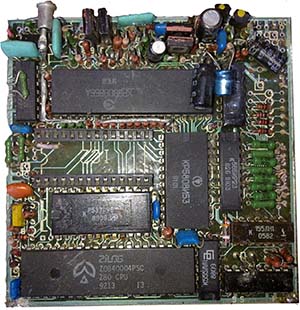 The board for caller ID contained much less chips, was cheaper to purchase, easier to install and configure. It is easily installed in the case of serially produced push-button phones, as opposed to computer. The mass user understood much better what benefit he could get from caller ID than from a gaming computer. The opportunity to see who is calling you before picking up the phone, find out in the evening who called in your absence, shut off unwanted calls using the “black list”, the auto redial function - all this turned out to be very popular and understandable to the ordinary man in the street.
The board for caller ID contained much less chips, was cheaper to purchase, easier to install and configure. It is easily installed in the case of serially produced push-button phones, as opposed to computer. The mass user understood much better what benefit he could get from caller ID than from a gaming computer. The opportunity to see who is calling you before picking up the phone, find out in the evening who called in your absence, shut off unwanted calls using the “black list”, the auto redial function - all this turned out to be very popular and understandable to the ordinary man in the street.
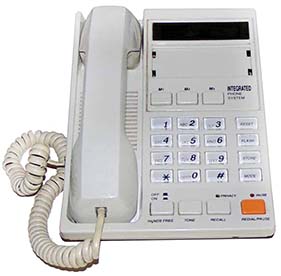 In the city there is a mass of small producers. Both software and hardware components of the Caller ID are quickly improved. The installation is outsourced to students. Then almost half of the MIET dormitory was engaged in the literal sense of knee soldering boards. Initially, the main sales go through the radio market in Mitino. However, companies that build regional distribution networks appear rather quickly and begin to concentrate production within themselves. Sometimes the structures of the consolidated companies resembled holdings, which provided small producers with a sales network, assistance in keeping accounts and even loans for the purchase of a complete set outside the high sales season. One of the most famous companies in Zelenograd was Remikon and Telesystems.
In the city there is a mass of small producers. Both software and hardware components of the Caller ID are quickly improved. The installation is outsourced to students. Then almost half of the MIET dormitory was engaged in the literal sense of knee soldering boards. Initially, the main sales go through the radio market in Mitino. However, companies that build regional distribution networks appear rather quickly and begin to concentrate production within themselves. Sometimes the structures of the consolidated companies resembled holdings, which provided small producers with a sales network, assistance in keeping accounts and even loans for the purchase of a complete set outside the high sales season. One of the most famous companies in Zelenograd was Remikon and Telesystems.
At that time, printed circuit boards were manufactured at state-owned Zelenograd factories, only they had expensive and large equipment. There was no problem with the production, but the factory technologists were reluctant to prepare the boards for production, but the demand for this service grew rapidly. It was then that a couple of people buddies from Remicon, who shouldered this job. The resulting company was developing very dynamically and now her name is known to almost all electronics engineers in Russia - this is the company Resonit.
In the first half of the nineties, many small firms emerge that find narrow niches with a large profit margin. A typical start-up of that time is a former amateur radio operator who earned a small initial capital on mediation. The flowering of small intermediaries was in 1991-92, then the subjects of this market began to quickly grow and become criminalized. The techies squeezed out of it found their niches in which they opened up small businesses.
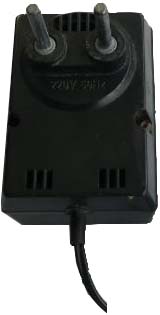 So one of my friends
So one of my friends amateur radio since high schooldevelops a simple and cheap switching power supply for caller ID. Transformer transformers widely used at that time were cumbersome and inconvenient, so the pulse set went well with the top devices, although they were somewhat more expensive. Surprisingly, in the development of the business he was helped by poor quality and, most importantly, a strong fluctuation from batch to batch of parameters of transistors and cores of coils. The bundle at that time was bought on the market and it was impossible to predict from which rejection of another batch of ferrite rings from which rejection you got. Therefore, often had to pick up the face values of passive parts from batch to batch. For this reason, stupid copying of its products by competitors which did not have specialists well versed in the intricacies of the processes occurring within the source, led to a mountain of marriage. As a result, for several years he managed to maintain almost a monopoly position in this narrow area.
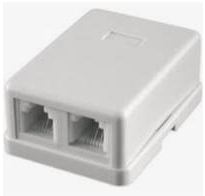 Later, they found another niche where deep knowledge of analog circuitry was useful — devices for wired telephony. In the assortment of his small enterprise there were splitters and combiners of telephone lines, unauthorized connection blockers, signal amplifiers, matching devices for connecting imported phones to the ordinary Russian line and to Kvant-type exchanges, etc. They were significantly cheaper than telephones with caller ID, but generated a good rate of return. At the best of times, several girls and one highly skilled serviceman worked on the assembly. Over time, to expand sales abroad of the radio market, the company became part of the Remikon holding and existed for a long time, finally bending in the second half of the two thousandth, when the use of cellular communication has reduced the interest in wired telephony to almost zero. At the beginning of the two thousandth, I tried to convince the owner of the need for a smooth transition to new areas of activity, but without success. He did not want to spend money on experiments.
Later, they found another niche where deep knowledge of analog circuitry was useful — devices for wired telephony. In the assortment of his small enterprise there were splitters and combiners of telephone lines, unauthorized connection blockers, signal amplifiers, matching devices for connecting imported phones to the ordinary Russian line and to Kvant-type exchanges, etc. They were significantly cheaper than telephones with caller ID, but generated a good rate of return. At the best of times, several girls and one highly skilled serviceman worked on the assembly. Over time, to expand sales abroad of the radio market, the company became part of the Remikon holding and existed for a long time, finally bending in the second half of the two thousandth, when the use of cellular communication has reduced the interest in wired telephony to almost zero. At the beginning of the two thousandth, I tried to convince the owner of the need for a smooth transition to new areas of activity, but without success. He did not want to spend money on experiments.
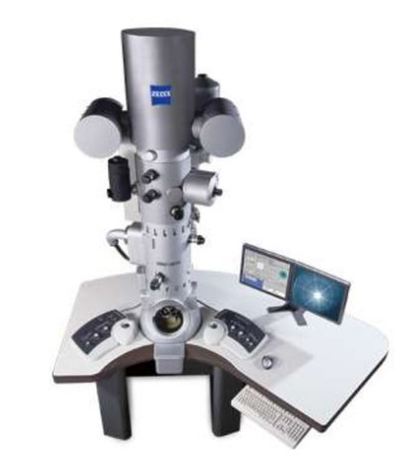 Over time, most businesses that started in the 90s went bankrupt and only a few managed to grow into large companies. I even know one that is directly involved in the development of semiconductor technologies and has become one of the world leaders in the production of probes for scanning tunneling electron microscopes.
Over time, most businesses that started in the 90s went bankrupt and only a few managed to grow into large companies. I even know one that is directly involved in the development of semiconductor technologies and has become one of the world leaders in the production of probes for scanning tunneling electron microscopes.
Of the companies that have not managed to grow up, a number of them are also living up to this day, among which, for example, manufacturers of specific medical equipment, radiation monitoring devices, etc.
The ideal time for the promotion of a business from scratch was the middle and second half of the nineties, the very ones to which the label “dashing” is stubbornly attached. Well, if we assume that this is in the sense that it was then possible to quickly start from scratch , I am ready to agree. In those days, there were a lot of factors favorable for the growth of small businesses:
Previous article in the cycle: Retrospective technology startups. Z3 - the first relay computer

In this article I continue the retrospective of startups. Fast forward from Germany to World War II to young Russia in the early 1990s of the last century. This time there will be many examples of how this happened in Zelenograd and an attempt to answer the question: “How and why did electronics business grow from scratch by leaps and bounds at that time?”
But first, let's take a quick look at the sunset era of the USSR star.
What is all this for?
В первом стартапе я принял участие на следующий год после окончания института, хотя тогда мы ещё не знали этого модного слова. С тех пор, я в том или ином роде, имел отношение к немалому их количеству. Большинство просуществовали недолго, но случались и успешные. Попытки анализа показали что удачная стратегия стартапа меняется в зависимости от общественно-политической ситуации, в которой он зарождается. Чтобы выбрать лучшую стратегию для сегодняшнего, не будет лишним разобраться каким образом достигался успех в прошлом, а затем попытаться обобщить информацию и выбрать лучший вариант развития на сегодняшний день. Начать я решил с ретроспективы нескольких удачных технологических стартапов, которые показались мне наиболее характерными для своего времени.
Business under the dim light of the sunset of the USSR
In late Soviet times, the production of electronics outside the public sector was very bad. In today's sense, it is simply absent. Yes, already then there were cooperatives, artels and citizens working under a patent, but in completely different areas.
In the late eighties, even the magazine “Radio” was not easy to get, let alone radio parts. Rare, especially in the provinces, radio stores were filled with customers, but as part of them there were, at best, sets of resistances and already then hopelessly outdated transistors of the MP39 type, and at very inflated prices.

The assortment of “do-it-yourself” stores was somewhat more interesting, however, they were far from being in every settlement. They could buy equipment that was decommissioned from salons in a semi-disassembled condition, and if you were lucky, it was a seriously discounted new product that did not pass quality control at work or had external defects. The main supplier of the most interesting and desired details was, of course, the money-clothing markets, commonly referred to as “flea market” in common people. There you could buy a lot of things - KT315 transistors, logic chips and even thyristors for color music. Particularly lucky had access to specialized landfills at the plants. Only testers were easily accessible from measuring instruments.

Private "production" was a craft under the roof of amateur radio, based on "communicated" from the production of parts and grouped around the relevant factories. Enthusiasts modified the radio receivers to receive broadcasting on the unused shortwave bands in the USSR, where foreign voices were jammed with less intensity, made the simplest color-music set-top boxes to order, modified power amplifiers and acoustics, assembled radio control equipment for models ... But all this is a maximum of several copies.
Findings:
Отсутствие радиоэлектронных компонентов в широкой продаже заставляло радиолюбителей изготавливать свои конструкции на основе разобранного бывшего в употреблении оборудования и “вынесенных” с заводов комплектующих. В результате даже при наличии схемы с кратким описанием повторить её и в единичном экземпляре было крайне сложно, произвести хотя бы мелкую серию почти невозможно. Каналы сбыта ограничивались ближним кругом знакомых. Незаконное предпринимательство каралось сурово. В таких условиях было возможно существование лишь радиолюбительства, изготовления и модификации устройств в единичных экземплярах.
How and why the first was the "Spectrum"
In the second half of the 80s in the USSR, with the help of children of diplomats, foreign students, athletes and other mysterious ways, individual instances of household computers, focused primarily on games, began to penetrate. However, it was much more difficult to meet the original ZX Spectrum in the USSR than, for example, such foreign PCs like the Atari, the Commodore 64 or MSX.
 Spectrum in almost all important parameters was clearly inferior to both Atari and MSX, and even the first Soviet home computer BK-0010/0011, whose architecture was built on the basis of an advanced 16-bit processor. However, when the ZX Spectrum fell into the hands of electronics engineers, they quickly were able to assess its strengths.
Spectrum in almost all important parameters was clearly inferior to both Atari and MSX, and even the first Soviet home computer BK-0010/0011, whose architecture was built on the basis of an advanced 16-bit processor. However, when the ZX Spectrum fell into the hands of electronics engineers, they quickly were able to assess its strengths.ZX Spectrum appeared thanks to the famous inventor - businessman Clive Sinclair in 1982 in the UK. He initially thought of as the cheapest home PC with color graphics support. To reduce the cost, it used the simplest keyboard of all 40 buttons, each of which carried up to six functions, including several BASIC operators. But the most unique in the Spectrum - is its graphical mode. Firstly, it is only one, unlike most other PCs of those years, which usually had several video modes, and secondly, the video system was capable of displaying 16 colors with a resolution of 256 × 192 pixels high enough for games and at the same time requiring less than 7 KB of video memory . Due to the wide border, the picture did not occupy too much of the screen, but it had good quality.
At that time, there were many specialists in the USSR specializing in the cloning of foreign products of electronic equipment, which made it possible in less than a year to create a simple and cheap clone ZX Spectrum on the basis of widespread domestic logic.
Comparative simplicity of the architecture is only one video mode, the lack of hardware sprites, character generator, scrolling, sound synthesizer, etc. allowed to very accurately simulate the "Spectrum" on the usual Soviet element base. Trivia, such as the incorrect operation of the video controller and the crookedly realized connection of the joystick, were outweighed by the low cost of assembly and the availability of components.
But the main advantage, compared with domestic domestic PCs produced at that time, was that it was developed a couple of orders of magnitude more games and other applications.
 The number of Spectrum-compatible Soviet models grew like a snowball, and in the early 1990s, literally dozens of factories produced them, greatly pushing back the original domestic developments to the background.
The number of Spectrum-compatible Soviet models grew like a snowball, and in the early 1990s, literally dozens of factories produced them, greatly pushing back the original domestic developments to the background.Circuitry Spectrum-compatible PC, developed by amateur enthusiasts in the second half of the 80s. The “Spectrum” scheme was unknown in details - in the original PC, one specialized ULA chip was used to reduce the cost of production instead of dozens of individual logic chips, hiding the logic of operation. Therefore, the authors of Spectrum-compatible computers were looking for their own solutions that simulate the operation of the prototype in accordance with the known external specifications - memory allocation, screen organization and the designation of control ports. Usually, Soviet counterparts contained about 45–80 microchips, which made them quite simple and cheap to manufacture. At the first stage, everything except the processor was produced by the domestic industry.

Since 1991, during the Spectrum boom, in Zelenograd
Findings:
Весной 1988 года был дан старт расцвету кооперативов. Немногим раньше, упрощён выезд за границу. Ослаб контроль над операциями с иностранной валютой и практика применения карающих за это законов стала более мягкой. В результате появилась возможность ввозить в “чемоданах” импортные комплектующие. Первыми стали процессоры и декодеры PAL-SECAM. Тотальный дифицит, особенно продуктов питания, активизировал деятельность “несунов” и бартерные отношения. Избыток необеспеченной денежной массы сделал возможным продажу в частные руки весьма дорогих изделий типа персональных бытовых компьютеров.
С первого взгляда может показаться странным, что наколенное производство электроники в СССР началось со столь сложных устройств, как компьютеры. Однако, если хорошо подумать, то и в этом можно найти закономерность — в те времена основным каналом распространения были знакомые и сарафанное радио. Массовая продажа была невозможна, а значит получить серьёзную прибыль было можно лишь производя достаточно дорогие устройства. Одноплатные компьютеры подходили как нельзя лучше — достаточно просты в сборке, а при наличии навыка работы с простейшими измерительными приборами и доступа к ним и в настройке.
С первого взгляда может показаться странным, что наколенное производство электроники в СССР началось со столь сложных устройств, как компьютеры. Однако, если хорошо подумать, то и в этом можно найти закономерность — в те времена основным каналом распространения были знакомые и сарафанное радио. Массовая продажа была невозможна, а значит получить серьёзную прибыль было можно лишь производя достаточно дорогие устройства. Одноплатные компьютеры подходили как нельзя лучше — достаточно просты в сборке, а при наличии навыка работы с простейшими измерительными приборами и доступа к ним и в настройке.
Businessmen from the hostel
At the end of the eight, imported circuits began to penetrate into significant quantities due to the cordon. Very quickly they got to the MIET hostel.
 By the time senior students were quite ready to master the Spectrum. I with three of my classmates threw off 150 rubles each and became the first owners of household computers BK-0010 that have just appeared in our hostel. It was possible to write simple programs on BASIC on it, but the game applications were practically absent. This prompted to start developing their own games. I will never forget the delights of graphics control in PDP-11 machine codes, since even the assembler was missing, and the basic in firmware ROM could not work with graphics. Taking into account the preservation of programs on a household tape recorder and the instability of the power grid, this was quite a non-trivial task.
By the time senior students were quite ready to master the Spectrum. I with three of my classmates threw off 150 rubles each and became the first owners of household computers BK-0010 that have just appeared in our hostel. It was possible to write simple programs on BASIC on it, but the game applications were practically absent. This prompted to start developing their own games. I will never forget the delights of graphics control in PDP-11 machine codes, since even the assembler was missing, and the basic in firmware ROM could not work with graphics. Taking into account the preservation of programs on a household tape recorder and the instability of the power grid, this was quite a non-trivial task.So without finishing the first game to the end, I became fascinated with mountain tourism and for a while computers moved into the background into my life. A couple of other “concessionaires”, on the contrary, got carried away in earnest. And now, towards the end of 1988, not only the imported 8-bit Z-80 processor , but also the circuit of the legendary Sinclair ZX Spectrum , fell into my hands by unknown means . By that time, the guys already had experience in assembling and adjusting the RC-86 computer on a blindfly, therefore, it was not too difficult to repeat this feat with the Spectrum.
The appearance of a gaming computer in their room could not go unnoticed by numerous friends. The room instantly turned into a sort of “showroom”. A week later, they made an offer to buy from which they could not refuse. Moreover, a virtual queue of potential customers was soon formed, ready to pay the money in advance.

In the hostel, consisting of 6 residential buildings, connected together by a common corridor, the news spread very quickly, even without the Internet. Soon my friends had a third partner who had a commercial vein.
Lyrical digression about picking
Зеленоград во времена СССР являлся флагманом производства персональных ЭВМ, именно там родилось и развивалось семейство ДВК. Компактный по территории, город спутник Москвы, в котором было собрано 8 крупнейших заводов радиоэлектронной промышленности СССР, был очень удобен для запуска собственного мелкосерийного производства. В нём проще, чем где бы то ни было, решались проблемы с элементной базой.
Одни из самых дефицитных и дорогих деталей — оперативная память К565РУ5 производилась Зеленограде, РПЗУ 573 серии делали здесь же. Любую логику было легко раздобыть у ребят с минского Интеграла, благо у нас в институте повышали квалификацию большое количество выходцев из него. Только в нашей группе было 5 ПОшников из Белорусии!
Производство электронных компонентов — одно из немногих, в котором есть понятие “выход годных”. Кроме этого, большая часть изделий, производимых на предприятиях города, шло на нужды ВПК, а это значит что уже готовые и вполне работоспособные микросхемы подолгу мучили в термоклиматических шкафах, трясли на вибростендах и подвергали другим изощрённым издевательствам.
Далеко не каждый чип проходил военную приёмку, но отбракованные микросхемы при этом с успехом могли трудиться внутри домашнего игрового компьютера. Нетрудно догадаться, что для бедного студента, проходящего практику на предприятии, существовал тысяча и один сравнительно честный способ благодаря которому условно годные микросхемы могли перекочевать не на свалку, а в его карман.
Во времена ещё действовавшего сухого закона почти весь набор микросхем на Спектрум можно было обменять на 2-3 бутылки дефицитной во времена действия «полусухого закона» жидкости. Оставался процессор Z-80 и платы. Вот за ним приходилось кататься в Ленинград или Прибалтику.
Одни из самых дефицитных и дорогих деталей — оперативная память К565РУ5 производилась Зеленограде, РПЗУ 573 серии делали здесь же. Любую логику было легко раздобыть у ребят с минского Интеграла, благо у нас в институте повышали квалификацию большое количество выходцев из него. Только в нашей группе было 5 ПОшников из Белорусии!
Производство электронных компонентов — одно из немногих, в котором есть понятие “выход годных”. Кроме этого, большая часть изделий, производимых на предприятиях города, шло на нужды ВПК, а это значит что уже готовые и вполне работоспособные микросхемы подолгу мучили в термоклиматических шкафах, трясли на вибростендах и подвергали другим изощрённым издевательствам.
Далеко не каждый чип проходил военную приёмку, но отбракованные микросхемы при этом с успехом могли трудиться внутри домашнего игрового компьютера. Нетрудно догадаться, что для бедного студента, проходящего практику на предприятии, существовал тысяча и один сравнительно честный способ благодаря которому условно годные микросхемы могли перекочевать не на свалку, а в его карман.
Во времена ещё действовавшего сухого закона почти весь набор микросхем на Спектрум можно было обменять на 2-3 бутылки дефицитной во времена действия «полусухого закона» жидкости. Оставался процессор Z-80 и платы. Вот за ним приходилось кататься в Ленинград или Прибалтику.
Friends enrolled in graduate school, study and research began to take a lot of time. To solder, tune, debug ready boards, search for cases, cram content into them ... it was too long and not too interesting. In such conditions, it was much more suitable to assemble sets for self-assembly for them than to assemble ready-made computers. Especially in the student environment of Zelenograd, where many were friends with a soldering iron. What my friends and do.

It cannot be said that the information in those days was very expensive - it was very difficult to access. There was neither the fact that the Internet - typewriters had to register with the KGB! The first scheme I had to shoot as a copy of tracing paper.
By that time I had already graduated from the institute and, unlike the children, I could not gain a foothold in graduate school.
Girls as terminators. Of business
 My friends' business ended as quickly and swiftly as it began. One of them did not share the girl with the merchant who joined them and there was a serious quarrel. For one and a half years of activity of their enterprise, the local market with a sales channel in the form of a word of mouth was almost saturated. The year of 1991 was approaching and many were no longer up to gaming computers. The number of components produced by “barter schemes” was limited. In order to move to other scales, everything had to be changed - the organizational structure, the delivery channels for bundling and marketing. Perhaps they would go for it, but in the summer, in
My friends' business ended as quickly and swiftly as it began. One of them did not share the girl with the merchant who joined them and there was a serious quarrel. For one and a half years of activity of their enterprise, the local market with a sales channel in the form of a word of mouth was almost saturated. The year of 1991 was approaching and many were no longer up to gaming computers. The number of components produced by “barter schemes” was limited. In order to move to other scales, everything had to be changed - the organizational structure, the delivery channels for bundling and marketing. Perhaps they would go for it, but in the summer, in Back from their tour they have not returned.
Findings:
Мои знакомые были не только хорошими технарями но и маркетологами. Собрав несколько компьютеров на коленях и распространив по ближайшему кругу знакомых они перешли на продажу наборов для сборки платы ZX Spectrum с пакетом документации, облегчающим самостоятельную настройку. Комната в общаге была превращена в шоурум, в котором можно было посмотреть на то, что из себя представляет готовый компьютер поиграть и заключить контракт о покупке. Сама передача набора производилась совсем другим человеком в “нейтральном месте”. По сути, на основе сарафанного радио, была организована сетевая структура — наборы покупали студенты, собирали и продавали уже по своим знакомым. В условиях общаги Института Электронной Техники такая структура позволяла с минимальными трудозатратами обеспечить объём продаж, достаточный для накопления первоначального капитала, но не слишком существенный для привлечения внимания контролирующих органов.
Стартап был вполне успешным и позволил менее чем за пару лет накопить капитал для эмиграции в США.
Стартап был вполне успешным и позволил менее чем за пару лет накопить капитал для эмиграции в США.
A few words about caller ID and the birth of Rezonita
Practically all firms known to me today, still engaged in the production of electronic devices in Zelenograd, began their history in those days.
The computer boom in the private sector in Zelenograd did not happen, but only because a much more interesting product appeared. Telephone with automatic caller ID - Caller ID.
 The board for caller ID contained much less chips, was cheaper to purchase, easier to install and configure. It is easily installed in the case of serially produced push-button phones, as opposed to computer. The mass user understood much better what benefit he could get from caller ID than from a gaming computer. The opportunity to see who is calling you before picking up the phone, find out in the evening who called in your absence, shut off unwanted calls using the “black list”, the auto redial function - all this turned out to be very popular and understandable to the ordinary man in the street.
The board for caller ID contained much less chips, was cheaper to purchase, easier to install and configure. It is easily installed in the case of serially produced push-button phones, as opposed to computer. The mass user understood much better what benefit he could get from caller ID than from a gaming computer. The opportunity to see who is calling you before picking up the phone, find out in the evening who called in your absence, shut off unwanted calls using the “black list”, the auto redial function - all this turned out to be very popular and understandable to the ordinary man in the street. In the city there is a mass of small producers. Both software and hardware components of the Caller ID are quickly improved. The installation is outsourced to students. Then almost half of the MIET dormitory was engaged in the literal sense of knee soldering boards. Initially, the main sales go through the radio market in Mitino. However, companies that build regional distribution networks appear rather quickly and begin to concentrate production within themselves. Sometimes the structures of the consolidated companies resembled holdings, which provided small producers with a sales network, assistance in keeping accounts and even loans for the purchase of a complete set outside the high sales season. One of the most famous companies in Zelenograd was Remikon and Telesystems.
In the city there is a mass of small producers. Both software and hardware components of the Caller ID are quickly improved. The installation is outsourced to students. Then almost half of the MIET dormitory was engaged in the literal sense of knee soldering boards. Initially, the main sales go through the radio market in Mitino. However, companies that build regional distribution networks appear rather quickly and begin to concentrate production within themselves. Sometimes the structures of the consolidated companies resembled holdings, which provided small producers with a sales network, assistance in keeping accounts and even loans for the purchase of a complete set outside the high sales season. One of the most famous companies in Zelenograd was Remikon and Telesystems.At that time, printed circuit boards were manufactured at state-owned Zelenograd factories, only they had expensive and large equipment. There was no problem with the production, but the factory technologists were reluctant to prepare the boards for production, but the demand for this service grew rapidly. It was then that a couple of people buddies from Remicon, who shouldered this job. The resulting company was developing very dynamically and now her name is known to almost all electronics engineers in Russia - this is the company Resonit.
Niche firms
In the first half of the nineties, many small firms emerge that find narrow niches with a large profit margin. A typical start-up of that time is a former amateur radio operator who earned a small initial capital on mediation. The flowering of small intermediaries was in 1991-92, then the subjects of this market began to quickly grow and become criminalized. The techies squeezed out of it found their niches in which they opened up small businesses.
 So one of my friends
So one of my friends  Later, they found another niche where deep knowledge of analog circuitry was useful — devices for wired telephony. In the assortment of his small enterprise there were splitters and combiners of telephone lines, unauthorized connection blockers, signal amplifiers, matching devices for connecting imported phones to the ordinary Russian line and to Kvant-type exchanges, etc. They were significantly cheaper than telephones with caller ID, but generated a good rate of return. At the best of times, several girls and one highly skilled serviceman worked on the assembly. Over time, to expand sales abroad of the radio market, the company became part of the Remikon holding and existed for a long time, finally bending in the second half of the two thousandth, when the use of cellular communication has reduced the interest in wired telephony to almost zero. At the beginning of the two thousandth, I tried to convince the owner of the need for a smooth transition to new areas of activity, but without success. He did not want to spend money on experiments.
Later, they found another niche where deep knowledge of analog circuitry was useful — devices for wired telephony. In the assortment of his small enterprise there were splitters and combiners of telephone lines, unauthorized connection blockers, signal amplifiers, matching devices for connecting imported phones to the ordinary Russian line and to Kvant-type exchanges, etc. They were significantly cheaper than telephones with caller ID, but generated a good rate of return. At the best of times, several girls and one highly skilled serviceman worked on the assembly. Over time, to expand sales abroad of the radio market, the company became part of the Remikon holding and existed for a long time, finally bending in the second half of the two thousandth, when the use of cellular communication has reduced the interest in wired telephony to almost zero. At the beginning of the two thousandth, I tried to convince the owner of the need for a smooth transition to new areas of activity, but without success. He did not want to spend money on experiments. Over time, most businesses that started in the 90s went bankrupt and only a few managed to grow into large companies. I even know one that is directly involved in the development of semiconductor technologies and has become one of the world leaders in the production of probes for scanning tunneling electron microscopes.
Over time, most businesses that started in the 90s went bankrupt and only a few managed to grow into large companies. I even know one that is directly involved in the development of semiconductor technologies and has become one of the world leaders in the production of probes for scanning tunneling electron microscopes. Of the companies that have not managed to grow up, a number of them are also living up to this day, among which, for example, manufacturers of specific medical equipment, radiation monitoring devices, etc.
Let's sum up
The ideal time for the promotion of a business from scratch was the middle and second half of the nineties, the very ones to which the label “dashing” is stubbornly attached. Well, if we assume that this is in the sense that it was then possible to quickly start from scratch , I am ready to agree. In those days, there were a lot of factors favorable for the growth of small businesses:
- commodity shortage
- high inflation, which prompted to get rid of the ruble mass
- free trade - in the early nineties you could stand on the first corner you liked and sell something
- the high cost of imported goods was a very high dollar rate, and the import of goods was poorly adjusted
- the actual absence of supervising compliance with standards and regulations of bodies
- high tax burden was compensated by the lack of enforcement of the legislation existing at that time
- destroyed commodity cash ties between enterprises and the plundering of the now unnecessary commodity stocks of the military-industrial complex made it possible to make purchases on extremely favorable terms, especially under barter schemes
- a large rate of profit and quick turnover due to the sale of goods on the market made it possible to quickly start with a minimum initial capital
- creating local products
- the absence of competitors from China, quickly copying everything
- incompatibility of USSR standards with the outside world
Previous article in the cycle: Retrospective technology startups. Z3 - the first relay computer
Only registered users can participate in the survey. Sign in , please.
